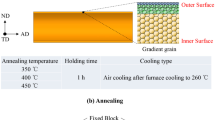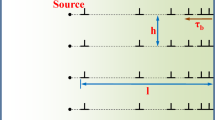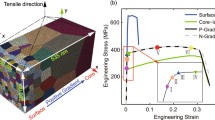Abstract
Grain size gradient materials exhibit superior strength and ductility due to their multiscale microstructures. A dislocation-based multiscale model was applied to study the effect of grain size gradient on the flow stress and deformation of gradient Aluminum. It is found that the grain orientation has a slight effect on the macroscopic behavior of gradient Aluminum, but without a strong texture fiber, such effect is neglectable. The strength depends not only on the average grain size but also on the grain size gradient. By varying the grain size gradient in the region connecting finest 200 nm grains and coarse grains in tens of microns, we found that the plastic flow stress is inverse proportional to the grain size gradient. A smooth transit could lead to a redistribution of the stress concentration and strain localization. The results on the deformation of different grain size gradients Aluminum shed light on processing gradient materials with an improved combination of strength–ductility.






Similar content being viewed by others
References
K. Lu: Science (80- ), 2014, vol. 345, pp. 1455–56.
Y. Zhu and X. Wu: Mater. Res. Lett., 2019, vol. 7, pp. 393–98.
E. Ma and T. Zhu: Mater. Today, 2017, vol. 20, pp. 323–31.
X. Wu and Y. Zhu: Mater. Res. Lett., 2017, vol. 5, pp. 527–32.
K. Lu: Jinshu Xuebao/Acta Metall. Sin., 2015, vol. 51, pp. 1–10.
T.O. Olugbade and J. Lu: Nano Mater. Sci., 2020, vol. 2, pp. 3–31.
Y. Ivanisenko, R. Kulagin, V. Fedorov, A. Mazilkin, T. Scherer, B. Baretzky, and H. Hahn: Mater. Sci. Eng. A, 2016, vol. 664, pp. 247–56.
J.Y. Kang, J.G. Kim, H.W. Park, and H.S. Kim: Sci. Rep., 2016, vol. 6, pp. 1–10.
T.H. Fang, W.L. Li, N.R. Tao, and K. Lu: Science (80- ), 2011, vol. 331, pp. 1587–90.
Z. Yin, X. Yang, X. Ma, J. Moering, J. Yang, Y. Gong, Y. Zhu, and X. Zhu: Mater. Des., 2016, vol. 105, pp. 89–95.
Y. Lin, J. Pan, H.F. Zhou, H.J. Gao, and Y. Li: Acta Mater., 2018, vol. 153, pp. 279–89.
X. Wu, P. Jiang, L. Chen, F. Yuan, and Y.T. Zhu: Proc. Natl Acad. Sci. USA, 2014, vol. 111, pp. 7197–7201.
X.L. Wu, P. Jiang, L. Chen, J.F. Zhang, F.P. Yuan, and Y.T. Zhu: Mater. Res. Lett., 2014, vol. 2, pp. 185–91.
Y. Liu, B. Jin, and J. Lu: Mater. Sci. Eng. A, 2015, vol. 636, pp. 446–51.
P. Jiang, J. Lu, and X.L. Wu: Mater. Sci. Forum, 2011, vol. 667–669, pp. 175–79.
X. Yang, H. Pan, J. Zhang, H. Gao, B. Shu, Y. Gong, and X. Zhu: Mater. Trans., 2019, vol. 60, pp. 1543–52.
P. Cao: Nano Lett., 2020, vol. 20, pp. 1440–46.
J. Zhao, X. Lu, F. Yuan, Q. Kan, S. Qu, G. Kang, and X. Zhang: Int. J. Plast., 2020, vol. 125, pp. 314–30.
Z. Zeng, X. Li, D. Xu, L. Lu, H. Gao, and T. Zhu: Extreme Mech. Lett., 2016, vol. 8, pp. 213–19.
Z. Li and F. Yang: Extreme Mech. Lett., 2017, vol. 16, pp. 41–48.
X. Lu, X. Zhang, M. Shi, F. Roters, G. Kang, and D. Raabe: Int. J. Plast., 2019, vol. 113, pp. 52–73.
H. Lyu, A. Ruimi, D.P. Field, and H.M. Zbib: Metall. Mater. Trans. A, 2016, vol. 47A, pp. 6608–20.
X.C. Liu, H.W. Zhang, and K. Lu: Scripta Mater., 2015, vol. 95, pp. 54–57.
H. Lyu, M. Hamid, A. Ruimi, and H.M. Zbib: Int. J. Plast., 2017, vol. 97, pp. 46–63.
E. Orowan: Proc. Phys. Soc., 1940, vol. 52, pp. 8–22.
J.E. Bailey and P.B. Hirsch: Philos. Mag., 1960, vol. 5, no. 53, pp. 485–97.
H. Lyu, N. Taheri-Nassaj, and H.M. Zbib: Philos. Mag., 2016, vol. 96, pp. 1883–1908.
J.P. Hirth: Philos. Mag., 2006, vol. 86, pp. 3959–63.
D. Liu, Y. He, B. Zhang, and L. Shen: Acta Mater., 2014, vol. 80, pp. 350–64.
S.S. Chakravarthy and W.A. Curtin: Proc. Natl Acad. Sci. USA, 2011, vol. 108, pp. 15716–20.
N. Taheri-Nassaj and H.M. Zbib: Int. J. Plast., 2015, vol. 74, pp. 1–6.
J.F. Nye: Acta Metall., 1953, vol. 1, pp. 153–62.
J. Luster and M.A. Morris: Metall. Mater. Trans. A, 1995, vol. 26A, pp. 1745–56.
T.R. Bieler, P. Eisenlohr, C. Zhang, H.J. Phukan, and M.A. Crimp: Curr. Opin. Solid State Mater. Sci., 2014, vol. 18, pp. 212–26.
J. Shi and M.A. Zikry: J. Mater. Res., 2011, vol. 26, pp. 1676–87.
T. Mura: Micromechanics of Defects in Solids, Martinus Nijhoff Publishers, Boston, 2012.
H.-J. Bunge: Texture Analysis in Materials Science: Mathematical Methods, Butterworth & Co., London, 2013.
W.F. Hosford, R.L. Fleischer, and W.A. Backofen: Acta Metall., 1960, vol. 8, pp. 187–99.
M.G. Lee, H. Lim, B.L. Adams, J.P. Hirth, and R.H. Wagoner: Int. J. Plast., 2010, vol. 26, pp. 925–38.
D. Li, H. Zbib, X. Sun, and M. Khaleel: Int. J. Plast., 2014, vol. 52, pp. 3–17.
N. Kermanshahimonfared, H. Askari, and I. Mastorakos: Metall. Mater. Trans. A, 2020, vol. 51A, pp. 400–09.
J.W. Wyrzykowski and M.W. Grabski: Philos. Mag. A, 1986, vol. 53, pp. 505–20.
H. Adachi, Y. Miyajima, M. Sato, and N. Tsuji: Keikinzoku/J. Jpn Inst. Light Met., 2014, vol. 64, pp. 463–69.
R. Valiev: Nat. Mater., 2004, vol. 3, pp. 511–16.
T.G. Langdon: Acta Mater., 2013, vol. 61, pp. 7035–59.
S. Shahrezaei, Y. Sun, and S.N. Mathaudhu: Mater. Sci. Eng. A, 2019, vol. 761, 138023.
Acknowledgments
This work was supported by National Natural Science Foundation of China for Young Researcher (Nos. 52101008) and the Fundamental Research Funds for the Central Universities (Nos. 3132022176). The statements made herein are solely the responsibility of the authors.
Conflict of interest
On behalf of all authors, the corresponding author states that there is no conflict of interest.
Author information
Authors and Affiliations
Corresponding author
Additional information
Publisher's Note
Springer Nature remains neutral with regard to jurisdictional claims in published maps and institutional affiliations.
Appendices
Appendix 1
The fitting of parameters q1–q7 with the evolution equations to [001] orientation tensile of single-crystal Aluminum is shown in Figure 7 (the red line). Then the set of parameters was adjusted based on the standard deviation of stress from simulations and experiments (the blue and purple line) from [111] loading directions in Figure 7.
Appendix 2
The equivalent plastic strain and mobile dislocation contour of homogeneous case with equivalent grain size are plotted on interpolation with a natural function with samples straining to 15 pct (Figure 8 ).
Tensile simulations of two homogeneous microstructure cases with identical regions but different numbers of grains (different average grain sizes, 3.5 and 50 μm, respectively). As shown in Figure 9 , the case with a smaller average grain size would have much higher strength but less strain hardening than the larger average grain size case. The average dislocation density in larger grains is much higher than that in smaller grains.
Rights and permissions
About this article
Cite this article
Lyu, H., Zhang, Y. & Li, H. The Effect of Grain Size Gradient on Plastic Deformation of Gradient Aluminum. Metall Mater Trans A 53, 3428–3440 (2022). https://doi.org/10.1007/s11661-022-06758-3
Received:
Accepted:
Published:
Issue Date:
DOI: https://doi.org/10.1007/s11661-022-06758-3







